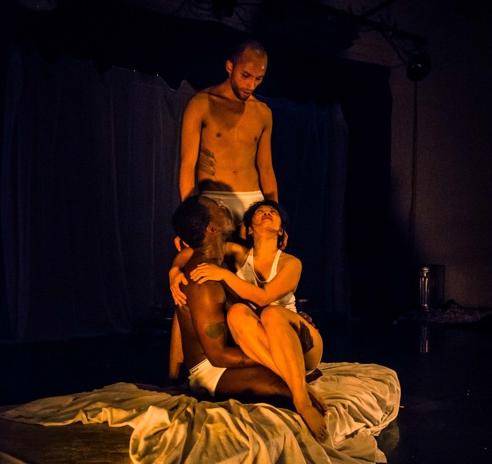The body does not lie — Anne Sexton
So often in the arts it seems like we spend an inordinate amount of time focused on how art engages our minds as opposed to our bodies, as if body were a mere vessel whose primary function was to shelter and nourish the brain. In fairness, this is how we treat our bodies in a non-artistic settings too, at best a cumbersome weight which anchors us to the physical world, at worst, a burden we long someday to be free of.
This constant mental disavowal of the body is one of the reasons the art of dance can appear so bold and so transgressive—the encumbrances of the body transformed into its greatest triumphs. In Brontez Purnell Dance Company’s “The Episodes,” playing at the Garage through March 16, everyday routines become ritual, and Purnell, Anthony Lucas, and Sophia Wang explore the mundane with an evening of choreographed mayhem and experiential frolic.
The evening begins with Gary Fembot-Brontez Purnell collaborative dance film “Free Jazz,” a hodge-podge of footage from various dance improvisations and “happenings” organized by Purnell over the course of an unspecified amount of time. In one scene, Punell races shirtless through the city streets carrying an immense tree branch over his head which he lays at the feet of a waiting coterie of fellow dancers, who encircle it solemnly and bend low to the ground.
In another he jumps around, fully clothed, in the midst of a wriggling, ecstatic house party, where dewy youths in hip sunglasses gyrate to the rhythm-heavy soundtrack. Bodies of every shape and size become vehicles of the beat, and the beat becomes a framework to encompass the onslaught of bodies, who strut and leap and cringe and embrace in riotous abandon.
Onstage, seated in galvanized washtubs, the dancers immediately draw attention to their bodies by forcing our brains to imagine the clammy indignity of sitting around in wet jeans. Wordlessly they mimic the functions of cleansing, stripping down and wringing the water out of their sopping denim, before rushing across the stage to put on their dance attire. On the video screen, a hand without a body scrawls chalk circles on the pavement, while the dancers roll deliberately on the ground, contracting and expanding their circle on the floor like breaths. To a cacophony of bells and crashing gongs, they leap into the air and slam themselves back to the ground, embodying the everyday frustration of reaching up only to be dragged back down, the constant tension between the possible versus the probable.
This tension thus established, the piece develops it further in several directions — relationship ruts versus artistic creation, morning rituals versus dreaming, avoidance versus acceptance.
In one scene the stage becomes scattered in drifts of crumpled paper, discarded words, like fallen leaves that can never be completely cleared away. A wave of Sisyphean hopelessness washes over the scene as Lucas doggedly chases every last scrap and Wang continually adds to the disarray. In another, the three sit on a striped couch, stupefied, static playing on the video screen, studio applause ringing hollowly across the stage before they “melt” away from each other and into their own fantasies.
The final scene brings the focus back on human interrelationship, a disembodied voice muses on being “torn between two lovers” while the trio collides in a series of twos and threes on a messy mattress, ending with all of them together in a nurturing cuddle puddle that appears to simultaneously define a connection between the three, without shutting out the oddience which surrounds their stage like a empathetic embrace. A body of bodies in a communion of flesh.

